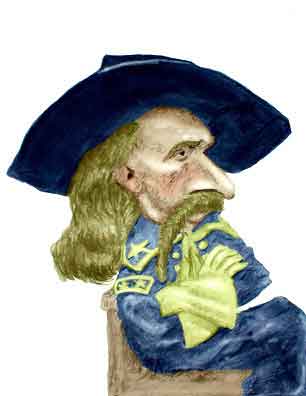If you get your history from Hollywood - as is increasingly common these days - you'll think that Shakespeare was once a starving artist, Salieri murdered Mozart, the Roman Emperor Commodus died fighting as a gladiator, and that one of William "Braveheart" Wallace's greatest victories was fought in open field.1
There are multiple references - easily found - about the "The [N] Most Historically Inaccurate Movies". These generally refer to movies where the scriptwriters spun fancy out of the cloth rather by altering historical details to fit the exigencies needed for compressing a story that might stretch out for decades to fit the time constraints imposed in a movie script. Unfortunately due to the nature of the medium, it really isn't possible to present verbatim history - even if that's the intent - in the cinema.
In the screenplay of the movie Wilde starring Stephen Fry and Jude Law much of the dialog is culled from the historical record including Oscar's own words. His double life - a kind, loving father and devoted husband by day and wild - no pun intended - party animal by night - is also very well depicted. Of course since Wilde is a film, the story has to be told in the form of action even if the actual source is more passive.
An example of "it-ain't-exact-history-but-it's-as-close-as-you-can-get-for-the-movies" is the strife shown between Lord Alfred Douglas and his father, John Sholto Douglas, the Marquess of Queensbury, which in the picture are verbal hurlings between the father and son. However, much of the communications between the two men was actually by correspondence. Even Lord Alfred's famous riposte "WHAT A FUNNY LITTLE MAN YOU ARE!" as delivered by Jude to Tom Wilkinson (who played Queensbury) was shouted in the movie. But in reality the famous taunt was sent by telegram. So a more factually accurate picture would have Lord Alfred and his father sitting around reading and writing letters to each other. But that wouldn't have made a particularly good movie.
And you'll think that Brevet General George Armstrong Custer personally met the Lakota warrior Crazy Horse, George was a stanch defender of Native American rights, he did all he could to keep gold hunters out of the Lakota's sacred Black Hills when a false story of a gold strike began circulating, and when he led his men on June 25, 1876, they were on a mission to rescue a cavalry company in Montana.
But then George and his soldiers were surrounded by mounted warriors who approached so close that that the final fighting was hand to hand. Then with his ammunition exhausted, George brandished his saber and finally fell to one last bullet fired by Crazy Horse. So George Armstrong Custer was the last man standing on Custer Hill at the Battle of the Little Bighorn.

George
Not Much Like Errol
The truth is that gold really was discovered in the Black Hills and George helped spread the word which did indeed bring a mass of miners into the Black Hills. This encroachment was actively encouraged by the US Government which was trying to force the Lakota to give up their land. It was this presence of white settlers in the sacred Native lands that touched off what is known as the Sioux War of 1876.
Nor did George lead his troops out to rescue another cavalry company. Instead he was on a scouting expedition as part of a military campaign organized by General Alfred Terry. In early 1876 the Federal Government had decreed that any of the Native people who refused to remain within their designated reservations were to be declared "hostile" and "belligerents". So they fell under the control of the US Army and not civilian authorities.
To this end Alfred drew up a plan where George and other officers were ordered to locate any of the errant "Indians" - then the usual designation - and get everyone back on their reservations. George - departing from Alfred's recommended itinerary and acting upon information provided by Major Marcus Reno - led twelve cavalry companies into the watershed of the Bighorn River where they found a large village camped on the tributary known as the Little Bighorn.
Figuring that a plan which had worked nine years earlier on the Washita River in present day Oklahoma would also be fine in Montana2, George divided his forces and sent Marcus in a direct attack on what was actually a conglomerate of separate villages of the Lakota, Cheyenne, and Arapaho. George promised Marcus he would provide support and after Marcus began his attack, George immediately took off with his own command. He moved east across the river and headed north.
Montana Territory was established in 1864 and was granted statehood in 1889. The site of the Battle of the Little Bighorn was then - and is now - part of the Crow Reservation.
Not understanding that attacking a village full of women and children might anger the husbands and fathers, Marcus was surprised to find a large number of warriors riding out to fight. Soon he began to wonder where George and his promised support was. So Marcus halted his attack and was soon driven back across the river. There he managed to reach the high ground where he and his soldiers dug in and for the next two days spent their time being peppered with sniper fire and wondering just where the heck George was.
Although the details of George's movements after he left Marcus remain a subject of scholarly study, his basic route is known. After he promised Marcus support - which Marcus really harped about - George moved to the higher ground east of the river and traveled north about three miles. When he reached a small gully called Medicine Tail Coulee he apparently tried to ford the river. But he was either driven back or he was making a feint to draw the warriors away from Marcus. George then led his troops north - possibly dividing his command further - until he set up a defense on what is now named Custer Hill about half a mile from the river.
Now it is true that George ended up surrounded. But it wasn't by mounted warriors riding up en masse within a few feet and firing rifles and shooting arrows into the huddled troopers. Instead, the soldiers were assailed by long range fire from ravines and behind rises. Usually arrows were not fired directly at individual soldiers but were loosed in high arcs which rained down on the men from above.
Only after most of the soldiers were dead did the warriors finally close in. The last group of cavalrymen ended up making a break for the river in a pursuit which the warriors likened to a buffalo hunt.
They Died With Their Boots On was the last movie to feature Errol Flynn and Olivia de Havilland. They had been in seven earlier pictures starting with Captain Blood in 1935. Errol and Olivia also famously appeared in The Adventures of Robin Hood and The Santa Fe Trail, the latter which featured a former sports announcer from Iowa.
By 1941, Anthony Quinn was a veteran actor and was just reaching the big time. Tony - as his friends called him - was not yet an American citizen having been born in Chihuahua, Mexico, as Manuel Antonio Rodolfo Quinn y Oaxaca. By Spanish naming conventions, we know his mother's surname was Oaxaca which is from the Aztec language - properly termed Nahuatl - and family tradition has Manuela as descended from Aztec royalty. So here we have an early example of an actor with Native American heritage playing a Native American.3
There is also the story that Tony's father, Francisco Quinn - he was born in Ireland - was part of the army of José Doroteo Arango Arambula. Doroteo, as we all know, took on the name - and rank - of General Francisco "Pancho" Villa.

Joe E. Brown
Olivia is now recognized as one of the most accomplished stars of the Golden Age of Hollywood. She started off in Alibi Ike (also released in 1935) playing the romantic interest of Joe E. Brown. Her last picture was The Fifth Musketeer in 1989, and she was the narrator for the documentary I Remember Better When I Paint in 2009. She lived until 2020, 104 years young.
Errol, though, lived a rather tumultuous and some would say a scandalous life. He was well aware of his reputation and this was reflected in the somewhat sardonic title of his autobiography My Wicked Wicked Ways. Known for his excessive partying, sporting with the ladies, and in general not taking care of himself, he found himself struggling with his later film career. However in the 1950's he began having a resurgence where among other roles he played Mike Campbell, the bankrupt and alcoholic boyfriend of Brett Ashely (Ava Gardner) in The Sun Also Rises. All in all he either starred in or had major roles in over 100 films.
After the Battle of the Little Bighorn, Elizabeth Custer spent the remaining 57 years of her life promoting the memory of her husband. She wrote her memoirs, Boots and Saddles, and lived long enough to be captured on motion picture film. One of the soldiers of the 7th Cavalry remembered her as a gracious lady and he even remembered George - so often pictured as a glory-hunting martinet - as friendly and affable.
After the Battle of the Little Bighorn, Crazy Horse and his followers were pursued by Colonel Nelson Miles and later by General George Crook. Crazy Horse finally surrendered in 1877 and was killed in captivity under somewhat mysterious circumstances. At the present time there is a monument to his memory being carved on a mountain in the Black Hills and when completed it will be one of the largest statues ever carved.
And just to set the record straight we have to mention that Shakespeare was born into the comfortable middle class, made a decent living as an actor while doubling as a playwright, and died a wealthy man. Salieri and Mozart later became good friends, the Roman Emperor Commodus met his end in the bathtub, and for some reason the movie Braveheart shows us the Battle of Stirling Bridge without a bridge.
References and Further Reading
They Died with Their Boots On, Errol Flynn (actor), Olivia de Havilland (actor), Raoul Walsh (director), Warner Brothers, 1941.
A Terrible Glory: Custer and the Little Bighorn - The Last Great Battle of the American West, James Donovan, Back Bay Books, 2009.
Cavalier in Buckskin, Robert Utley, Oklahoma, 1988.
Anthony Quinns, Melissa Amdur, Hispanics of Achievement, Chelsea House Publications, 1993, 1999.
Crazy Horse and Custer: The Parallel Lives of Two American Warriors, Stephen Ambrose, New American Library, 1986.
"10 Braveheart Inaccuracies: Historical Blunders in the Mel Gibson Film About the Wars of Scottish Independence", The Scotsman, Finlay Greig, May 2020.
"15 Most Historically Inaccurate Movies Ever", Jack Delaney, Screen Rant, February, 28, 2016.
Return to CooperToons Caricatures
Return to CooperToons Homepage

